Long Call Vertical Spread
Long Call Vertical Summary
- A long call vertical spread is a bullish position involving a long and short call with different strike prices in the same expiration.
- When setting up a call debit spread, the long call is more expensive than the short call since it is closer to the money, resulting in a net debit.
- Selling a call at a higher strike price against the long call can reduce the overall cost of establishing a bullish position, but it also caps the upside profit potential.
- Max profit occurs when the entire spread expires ITM and is calculated by subtracting the debit paid from the long call spread width.
- The debit paid for the long call vertical spread is an investor's max loss if it expires OTM and is worthless at expiration. However, if the underlying expires in between the two strikes, the long call option will be auto-exercised and you will have ownership of 100 long shares. Once the exercise is done, you will assume the risk of stock ownership.
Long Call Vertical Spread Strategy
A long call vertical spread is a bullish strategy where the trader wants the underlying price to rise. A long call vertical consists of two call options in the same expiration: a long call closer to the stock price and a short call further out-of-the-money (OTM) than the long call. When setting up a call debit spread, the long call is worth more than the short call, resulting in a net debit when establishing. Selling a call at a higher strike price against the long call reduces the overall cost of establishing a bullish position and is generally cheaper than buying a single call option outright. However, by selling a call against it, upside profit potential is capped.
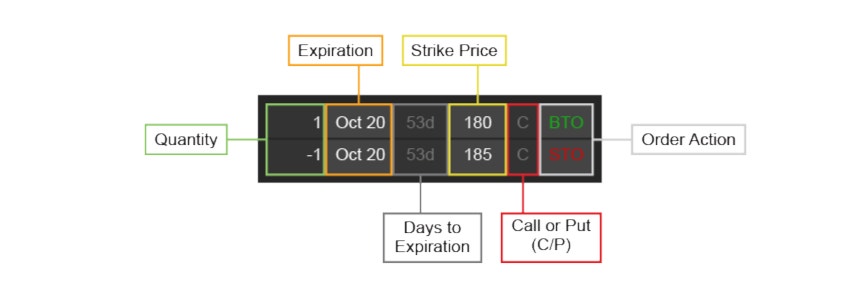
The value of a long call vertical spread can appreciate as the price of the stock or ETF rises and approaches the long strike price and, ideally, past the short call's strike price. The ideal scenario is when the stock price rises above the short call strike at expiration so it can appreciate to its maximum value, which is its spread width.
Conversely, the value of a long call vertical spread can depreciate when the price of the underlying it tracks falls. Additionally, due to time decay, the value of the spread can depreciate over time if the underlying price remains constant and does not approach or exceed the long call’s strike price.
Unlike buying a single call option outright, a long call vertical spread allows you to reduce your overall cost to deploy the bullish strategy. Due to the lowered cost, the max loss is less than buying the call outright. However, the max profit of the strategy is capped because of selling a further out-of-the-money call against the long call.
Investors can close or sell the long call spread for a higher amount than what the trader paid for it to realize a profit before expiration or sold for less than the debit paid up front to minimize the max loss. In other words, the trade does not have to be held to expiration to yield a potential profit or loss.
Expiration Risk for Long Call Vertical Spreads
A defined-risk vertical spread is no longer a defined risk position if one leg of the spread expires in the money and the other does not. The risk lies with pin risk on the day of expiration, which is the risk surrounding the uncertainty of where the underlying will close to determine whether an option is in or out of the money. Options that expire in the money by $0.01 or more are auto-exercised, resulting in the long call option converting to 100 long shares of stock. In the case of a long call vertical spread, a partially ITM spread will convert to 100 long shares, and the OTM short call option would not get assigned to offset the long shares [by selling the shares].
Additionally, any options strategy involving short options, including a long call vertical, may face after-hours risk on the day of expiration. In summary, although the vertical may have expired OTM based on the stock's closing print, an OTM short call option can become ITM based on any extreme upward price movement after the market close, resulting in an unexpected assignment of short shares. As a result, the investor would assume the (unlimited) risk of 100 short shares per contract assigned. The only way to eliminate after-hours risk is by closing any short options positions before expiration.
Due to the risk of exercise and assignment, it's crucial to have a plan and manage risk like closing or rolling the position before expiration, especially when the account does not have sufficient account equity to take on the resulting position. Please visit the tastytrade Help Center to learn more about Expiration Risk.
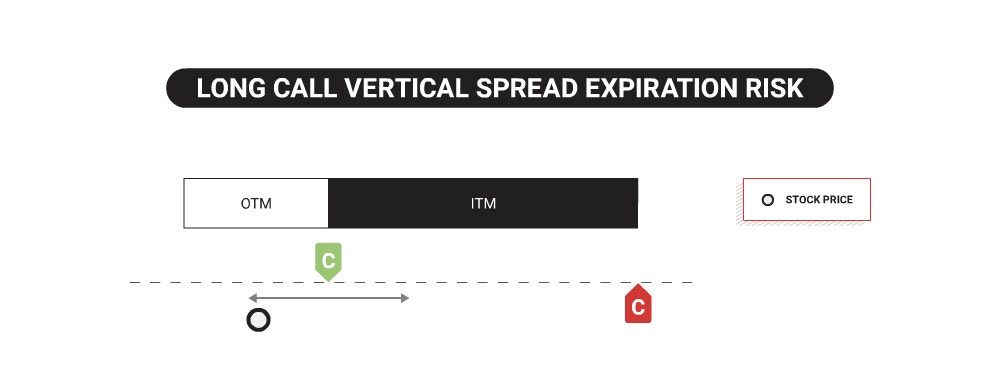
Profit & Loss Diagram of a Long Call Vertical Spread
A long call vertical can become profitable if the underlying approaches the long call’s strike or surpasses it by the amount of the debit paid for the entire spread. Unlike outright long calls, the profit of the long call vertical spread caps after it breaches the short strike, which the flattened green area below illustrates.
Losses on the long call spread can occur if the underlying does not surpass the breakeven point, as shown where the profit/loss line converges on the x-axis. The breakeven point can be calculated by adding the net debit paid to open the trade to the long strike price. The maximum loss on a long call vertical is only the net debit paid, which the flattened red area of the diagram illustrates, and occurs when the spread expires out-of-the-money and worthless.
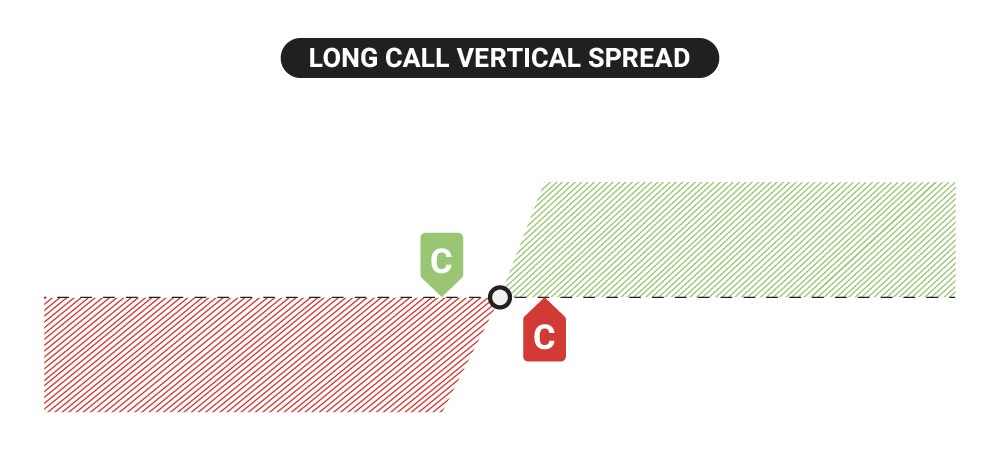
What’s Required for a Long Call Vertical Spread?
Two call options in the same expiration.
- Buy to Open +1 long call
- Sell to Open -1 short call (any strike price above the long call)
Example of a Vertical Call Debit Spread
XYZ currently trading @ $45
- +1 XYZ 50-strike call @ $3 debit
- -1 XYZ 55-strike call @ $1 credit
Paid a $2 debit ($200 total)
Spread Width: Short strike – Long strike = 55 – 50 = $5
Factor | Explanation |
|---|---|
Time Decay Affect | Works against the option’s value |
Max Profit | (Spread width) x 100 – Total debit paid (55 – 50) x 100 – ($2 x 100)= $300 |
Max Loss | Total debit paid $200 |
Breakeven Price (at expiration) | Long Strike price + Debit paid $50 + $2 = $52 |
Buying Power Requirement | Debit paid $200 |
Account Type Required | Margin and IRA |
Other Names |
|
Factor | Explanation |
|---|---|
Time Decay Affect | Works against the option’s value |
Max Profit | (Spread width) x 100 – Total debit paid (55 – 50) x 100 – ($2 x 100)= $300 |
Max Loss | Total debit paid $200 |
Breakeven Price (at expiration) | Long Strike price + Debit paid $50 + $2 = $52 |
Buying Power Requirement | Debit paid $200 |
Account Type Required | Margin and IRA |
Other Names |
|
How to Place a Long Call Vertical Spread Order on the tastytrade Desktop Platform
Using the Strategy Menu
- Enter a symbol.
- Navigate to the Trade tab.
- Go to the Table mode.
- Click on an expiration date to expand.
- Click the Strategy Menu and locate the Vertical strategy. From left to right, click each column to display Long, Call, and Go.
- The long strike order will display a green bar, and the short strike will display in a red bar in the expanded expiration. Drag each strike up or down to the desired strike.
- Go to the order ticket to determine the quantity, price, time-in-force (TIF), etc. before clicking "Review & Send." Review everything including commissions and fees before sending the order.
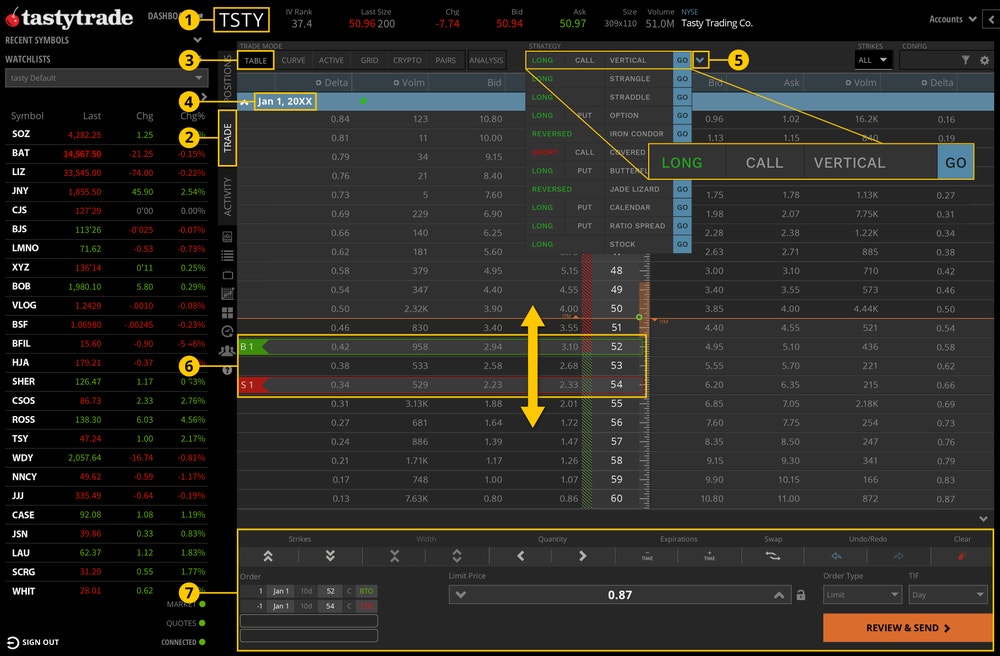
Building it Manually
- Enter a symbol.
- Navigate to the Trade tab.
- Go to the Table mode.
- Click on an expiration date to expand.
- Click the Ask price of the long leg.
- Click the Bid price of the short leg.
- Go to the order ticket to determine the quantity, price, time-in-force (TIF), etc. before clicking "Review & Send." Review everything including commissions and fees before sending the order.
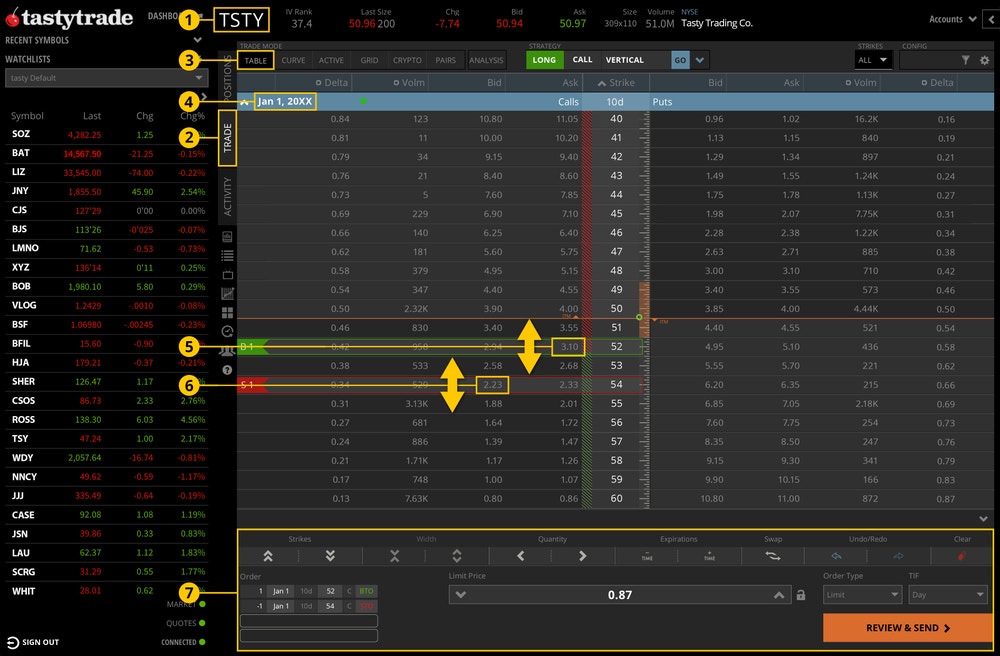
Options involve risk and are not suitable for all investors as the special risks inherent to options trading may expose investors to potentially significant losses. Please read Characteristics and Risks of Standardized Options before deciding to invest in options.
Multi-leg option strategies incur higher transaction costs as they involve multiple commission charges.
All investments involve risk of loss. Please carefully consider the risks associated with your investments and if such trading is suitable for you before deciding to trade certain products or strategies. You are solely responsible for making your investment and trading decisions and for evaluating the risks associated with your investments.